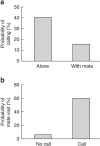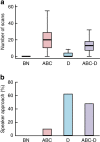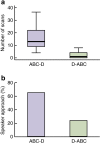Experimental evidence for compositional syntax in bird calls
- PMID: 26954097
- PMCID: PMC4786783
- DOI: 10.1038/ncomms10986
Experimental evidence for compositional syntax in bird calls
Abstract
Human language can express limitless meanings from a finite set of words based on combinatorial rules (i.e., compositional syntax). Although animal vocalizations may be comprised of different basic elements (notes), it remains unknown whether compositional syntax has also evolved in animals. Here we report the first experimental evidence for compositional syntax in a wild animal species, the Japanese great tit (Parus minor). Tits have over ten different notes in their vocal repertoire and use them either solely or in combination with other notes. Experiments reveal that receivers extract different meanings from 'ABC' (scan for danger) and 'D' notes (approach the caller), and a compound meaning from 'ABC-D' combinations. However, receivers rarely scan and approach when note ordering is artificially reversed ('D-ABC'). Thus, compositional syntax is not unique to human language but may have evolved independently in animals as one of the basic mechanisms of information transmission.
Figures




Comment in
-
Commentary: Experimental evidence for compositional syntax in bird calls.Front Psychol. 2016 Aug 3;7:1171. doi: 10.3389/fpsyg.2016.01171. eCollection 2016. Front Psychol. 2016. PMID: 27535181 Free PMC article. No abstract available.
References
-
- Chomsky N. Aspects of the Theory of Syntax MIT Press (1965).
-
- Hauser M. D., Chomsky N. & Fitch W. T. The faculty of language: what is it, who has it, and how did it evolve? Science 298, 1569–1579 (2002). - PubMed
-
- Fitch W. T. Evolution of Langage Cambridge Univ. Press (2010).
-
- Hockett C. F. in Animal Sounds and Communication eds Lanyon W. E., Tavolga W. N. 392–430American Institute of Biological Sciences (1960).
-
- Marler P. in The Origin and Diversification of Language eds Jablonski N. G., Aiello L. C. 1–20Univ. California Press (1998).
Publication types
MeSH terms
LinkOut - more resources
Full Text Sources
Other Literature Sources

